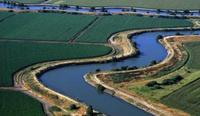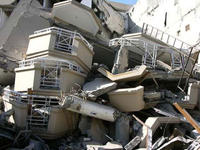-
Thorium could be answer to South Africa's energy woes

South African scientists are increasingly touting thorium as a viable solution for the country’s energy woes; scientists believe that South Africa could use its plentiful reserves of thorium, a radioactive rare earth metal, to generate greenhouse gas-free electricity; South Africa’s aging energy infrastructure has led to rolling blackouts and energy rations; South Africa currently generates 78 percent of its energy from coal making it one of the largest contributors of greenhouse gases in the world; thorium is a better alternative to uranium in nuclear power production as it cannot be weaponized, does not need to be converted or enriched, its radioactive waste breaks down faster, and is less expensive and environmentally friendlier to extract
-
-
Aging U.S. natural gas pipelines are ticking time bombs

Fourteen people are dead, dozens injured and entire neighborhoods are gone in the wake of three massive gas pipeline explosions in San Bruno, California; Philadelphia and Allentown, Pennsylvania, over the past six months; more than 2,800 significant gas pipeline accidents have been recorded across the United States since 1990 — a third of them causing deaths and significant injuries; there are more than 210 natural gas pipeline systems, made of cast iron, steel, and plastic with more than 21,000 miles running through heavily populated areas
-
-
China plans to build alternative to Panama Canal
China recently struck a deal with Colombia to build a railway system that would connect the Atlantic to the Pacific oceans; China hopes this link will create a viable alternative to the Panama Canal; the railway would help ease China’s growing demand for raw materials, particularly coal, and act as an additional outlet for Chinese exports; Colombia is the fifth largest coal producer in the world, but most of its coal is exported through its ports on the Atlantic side; trade between China and Colombia has skyrocketed from $10 million in 1980 to $5 billion in 2010
-
-
China races to claim Arctic resources
As temperatures around the world continue to rise and the ice in the Arctic Ocean melts, the once frozen seas are increasingly open for exploration and countries have been scrambling to claim the region’s vast resources; several countries including Canada, the United States, and Russia have all sought to expand their territorial claims over the region and now new countries like China are pushing in; Chinese researchers recently sailed to within 120 nautical miles of the North Pole; only a few years prior, this trip would have been impossible due to the thick ice in the ocean that can be more than 30 feet thick; scientists estimate that during the summer months, the Arctic Ocean could be ice-free by as early as 2013 or as late as 2060
-
-
In a setback, Iran unloads nuclear fuel from Busheher reactor

Iran announced Saturday it was unloading nuclear fuel from the Bushehr reactor, signaling more problems for the Russian-built plant after decades of delay; a source close to the project said the fuel was being unloaded on the suspicion that metal particles from nearly 30-year old equipment used in the construction of reactor core had contaminated the fuel; a senior Iranian official said earlier this month that suggestions should be investigated that the Stuxnet computer worm, believed to have been an attempt by Iran’s enemies to sabotage the nuclear program, had caused harm to the 1,000 megawatt Bushehr reactor
-
-
Contradictions in U.S. cybersecurity policy
The United States wants a secure cyberspace, but its intelligence agencies have found enormous utility in using their own computer hacking capabilities to collect confidential information from foreign adversaries; this raises the question of how the U.S. government can push for global cybersecurity while at the same time using cyber means to collect intelligence on potentially threatening regimes such as Iran
-
-
Expert urges broad reforms in managing California's water

Most threatening to California’s water situation is the vulnerability of the hub of the state’s fresh water system, the Sacramento-San Joaquin delta, which drains water from the northern Sierra mountains; over the past century, farmers have built a network of more than 1,700 kilometers of levees to protect farmland in the delta from floodwaters; those levees are weak and vulnerable to earthquakes, seasonal floods, and rising waters expected as a result of climate change; the failure of even a fraction of the levees would draw massive amounts of saltwater in from San Francisco Bay, forcing the state to shut off the pumps, cutting off water supplies for many months, and costing the state’s economy billions of dollars
-
-
Ancient catastrophic drought a warning about current warming trends
Extreme megadrought in Afro-Asian region likely had consequences for Paleolithic cultures; the records show that one of the most widespread and intense droughts of the last 50,000 years or more struck Africa and Southern Asia 17,000 to 16,000 years ago; the “H1 megadrought” was one of the most severe climate trials ever faced by anatomically modern humans; Africa’s Lake Victoria, now the world’s largest tropical lake, dried out, as did Lake Tana in Ethiopia, and Lake Van in Turkey; the Nile, Congo, and other major rivers shriveled
-
-
Insider threat problem topic of a GovSec panel
A recent batch of leaked cables from the State Department reveals concerted efforts by terrorist organizations to obtain WMDs and the danger that “insider threats” pose at facilities that house radioactive materials; in September 2009 two employees at the Rossing Uranium Mine in Namibia smuggled nearly half a ton of yellowcake out of the facility; the pair was eventually caught, but 550 pounds were not intercepted and have gone missing; another cable expressed fears that an employee working in one of Pakistan’s nuclear facilities could “gradually smuggle enough material out to eventually make a weapon”; these incidents are but two examples of the growing danger insiders, motivated by money or ideology, pose
-
-
DHS information officers discuss the future of technology at AFCEA
The senior technology officials of several DHS agencies gathered for a roundtable discussion at the AFCEA Homeland Security Conference in Washington, D.C. to outline their priorities, challenges, and plans for procuring technology and implementing capabilities at their respective departments; information officers from TSA, the U.S Coast Guard, the National Protection and Programs Directorate, and Citizen and Immigration Services were present; each official expressed similar plans to increase mobile access to data, digitize records, establish national databases, and streamline the flow of information; officials believe these remotely accessible databases can also help reduce costs and enhance customer service; the officials also noted the difficulty in hiring qualified personnel with cyber security skills
-
-
NZ earthquake illustrates risks for U.S. west coast

The recent 6.3 magnitude earthquake in Christchurch, New Zealand, killed many more people and caused far more damage than the September 2010 7.1 magnitude earthquake which struck the same area; the reason: even though this earthquake was weaker than last year’s event, it was much shallower; was situated directly under Christchurch; hit during the lunch hour when more people were exposed to damage; and shook sediments that were prone to “liquefaction,” which can magnify the damage done by the ground shaking; scientists say the same description nicely fits many major cities and towns in Washington, Oregon, California, and British Columbia
-
-
Common clam to help clean oil-filled waters

Clams are bottom-dwelling filter feeders, obtaining nutrients by filtering the water around them; researchers at Southeastern Louisiana University are studying the lowly Rangia clam to determine whether the organism can contribute to helping clean oil-polluted waters
-
-
Danger building up behind aging, vulnerable dams
Of the U.S. 85,000 dams, more than 4,400 are considered susceptible to failure; a 2009 report put the cost of fixing the most critical dams — where failure could cause loss of life — at $16 billion over twelve years, with the total cost of rehabilitating all dams at $51 billion; those figures do not include dams among the approximately 3,000 that are owned by the federal government; the Army Corps of Engineers, for example, says that more than 300 of the roughly 700 dams it is responsible for need safety-related repairs, and estimates the total fix-up bill at about $20 billion
-
-
Satellite system to provide earlier earthquake warnings
British and Russian scientists are planning a satellite system that will monitor seismic activity from space in the hope of one day predicting the occurrence of earthquakes and volcanic eruptions.
The TwinSat project will put one micro-sized and one nano-sized satellite into low earth orbit some 400 kilometers apart, which will work in unison to collect and interpret electromagnetic signatures from the ground -
-
Oil giants struggle to find more oil
Last week Exxon Mobil Corp’s annual financial report showed that the world’s largest oil company was struggling to find more oil; the report revealed that Exxon had only replaced 95 percent of the oil that it pumped out of the ground over the last decade; Exxon now holds more natural gas reserves than oil for future production; the company has replaced its natural gas reserves at higher rates than oil; in recent years large western oil companies have found that most of the accessible oil fields have been tapped, while new regions have been difficult to access both technically and politically; in 2010 Chevron announced that it had only replaced one barrel for every four it produced and Royal Dutch Shell PLC recently announced that next year it will produce more gas than oil for the first time in its company’s 104-year history
-
More headlines
The long view
Water Wars: A Historic Agreement Between Mexico and US Is Ramping Up Border Tension
As climate change drives rising temperatures and changes in rainfall, Mexico and the US are in the middle of a conflict over water, putting an additional strain on their relationship. Partly due to constant droughts, Mexico has struggled to maintain its water deliveries for much of the last 25 years, deliveries to which it is obligated by a 1944 water-sharing agreement between the two countries.
Trump Is Fast-Tracking New Coal Mines — Even When They Don’t Make Economic Sense
In Appalachian Tennessee, mines shut down and couldn’t pay their debts. Now a new one is opening under the guise of an “energy emergency.”
Smaller Nuclear Reactors Spark Renewed Interest in a Once-Shunned Energy Source
In the past two years, half the states have taken action to promote nuclear power, from creating nuclear task forces to integrating nuclear into long-term energy plans.
Keeping the Lights on with Nuclear Waste: Radiochemistry Transforms Nuclear Waste into Strategic Materials
How UNLV radiochemistry is pioneering the future of energy in the Southwest by salvaging strategic materials from nuclear dumps –and making it safe.
Model Predicts Long-Term Effects of Nuclear Waste on Underground Disposal Systems
The simulations matched results from an underground lab experiment in Switzerland, suggesting modeling could be used to validate the safety of nuclear disposal sites.
